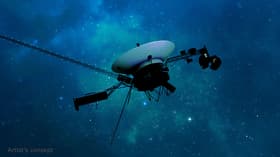NASA Voyager mission engineers are preparing a software patch that will allow the thrusters aboard the Voyager 1 and 2 interstellar probes to continue operating for another five years, keeping the spacecraft in communications with Earth.
The Voyager spacecraft have been in service since their launch in 1977 and have exceeded their life expectancy many times over. They're a testament to the teams that designed them, but after almost half a century their very longevity is creating new problems that were never anticipated.
One of these is that the hydrazine-fueled thrusters used to keep the Voyagers aiming their high-gain antennas at Earth are showing their age. Though they still have enough propellant to last until 2037 thanks to careful conservation by Mission Control at the Jet Propulsion Laboratory (JPL) in Pasadena, California, the thrusters themselves could do with a good cleaning.
The problem is that over the years each thruster firing has left residue in the system, which has been building up slowly but surely. If there's too much buildup, the fuel lines could clog and that would be it for the spacecraft.
To prevent this, NASA engineers are working on a software patch that will order the Voyagers to fire their thrusters less often but for longer periods to maintain their attitude. In addition, the probes will be told to allow their fix on Earth to drift more than previously before they go into emergency mode. The space agency says that this will result in some data loss, but more data returned in the long run.
In addition, the patch will repair a glitch that in 2022 caused Voyager 1's Attitude Articulation and Control System (AACS) to misdirect commands. The software update isn't without risk. Not only are the Voyagers obsolete and traveling through an extremely hostile environment, but it takes 18 hours for a signal to travel from Earth to the probes. This means that it would take a minimum of 36 hours before Mission Control noticed a problem with the upload. As a result, the first transmission will be made to Voyager 2 before an attempt is made with Voyager 1.
The hope is that the upgrades will extend the service life of the thrusters by at least five years. Since the nuclear batteries aboard the spacecraft are only expected to last another two years, this will leave a considerable margin of error.
"This far into the mission, the engineering team is being faced with a lot of challenges for which we just don’t have a playbook," said Linda Spilker, project scientist for the mission JPL. "But they continue to come up with creative solutions."
Source: NASA

